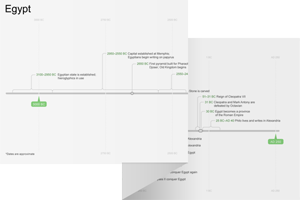2:1–15 In the opening of this section, Zephaniah declares that the only hope for the children of Israel is repentance (Zeph 2:1–3). He calls the nation to gather together and seek Yahweh before the announced decree takes effect. Zephaniah begs the inhabitants of Judah to humble themselves, obey Yahweh’s commands, and be filled with righteousness in the hope that they will then be hidden on the day of Yahweh’s anger (v. 3; compare Amos 5:15). Having described the judgment of Judah (Zeph 1:4–15), the prophet turns his attention to the nations surrounding Judah (vv. 4–15). |
2:3 you afflicted of the land Refers to those who are humble (Hab 2:4) and obedient to Yahweh or possibly to those who are afflicted and poor (see Exod 1:11; Ps 76:9; Isa 58:10; Amos 8:4).
2:4 The four cities mentioned in this verse (Gaza, Ekron, Ashkelon, and Ashdod) were part of the “Philistine pentapolis” (see note on Jer 25:20). Each of these cities was governed by a lord (Judg 3:3). Zephaniah doesn’t mention the fifth city, Gath, suggesting that Gath had already been destroyed by the time of his ministry (2 Chr 26:6; Amos 1:6–8; Zech 9:5–7). |
Gaza An important center of trade located on the Mediterranean shore about 40 miles south of Jaffa. Probably the oldest of the Philistine cities. Identified with the modern Tell Harube.
Ashkelon A commercial seaport situated on the Mediterranean shore between Jaffa and Gaza. Identified with the modern Ashkelon.
Ashdod A heavily fortified city located about two miles inland of the Mediterranean Sea and nine miles north of Ashkelon. Identified with the modern Ashdod.
Ekron The northernmost Philistine city, located approximately 35 miles southwest of Jerusalem on the edge of the Shephelah. Identified with the modern Tell Miqne.
2:5 Woe to The prophet uses the term here as a divine threat; he is introducing a woe pronouncement.
the Kerethites A title related to Crete, the native land of the Philistines.
O Canaan, land of the Philistines A region stretching from the border of Egypt in the south to Lebanon in the north, bordered on the west by the Mediterranean Sea and the east by the Jordan River.
2:6 pastures and meadows for Because the coastal plain was filled with caves and meadows, it was highly sought after by shepherds.
2:7 shall be mindful of them He will care for them as a shepherd cares for his sheep.
2:8 Moab Neighbor of Israel located east of the Jordan River and the Dead Sea. See note on 2 Kgs 13:20.
the Ammonites Neighbors of the Israelites who lived east of the Jordan River, just north of the Moabites. See note on 1 Chr 19:1.
my nation The Israelites were God’s people, the nation that He had redeemed from Egypt (e.g., Exod 3:7, 10; 5:1).
2:9 Yahweh of hosts A title identifying God as the leader of the heavenly armies. See note on Nah 2:13.
like Gomorrah Sodom and Gomorrah were cities located near the Dead Sea during the time of Abraham (Gen 19). God judged the two cities for their wickedness. The territory where they once stood is a dry, desolate wasteland full of thorn bushes and salt pits.
2:12 O Cushites The reference to Cushites (also rendered “Ethiopians”) may be intended to include Egypt. The Cushites invaded and defeated Egypt in 716 bc. The Cushite dynasty in Egypt lasted until 663 bc, when the Assyrian king, Ashurbanipal, took the city of Thebes. On Egypt, see note on Mic 6:4.
invaded and defeated Egypt in 716 bc. The Cushite dynasty in Egypt lasted until 663 bc, when the Assyrian king, Ashurbanipal, took the city of Thebes. On Egypt, see note on Mic 6:4.
2:13 Assyria The Assyrians migrated north from Babylon and settled in the region surrounding Nineveh (Gen 10:11; see note on Mic 5:5).
Nineveh One of the four great cities of Assyria. See note on Jonah 1:2.
2:15 that lived securely Nineveh was believed to be impregnable because of its strategic location on the Tigris River (compare Zeph 3:8).
I am, and there is none besides me This and similar phrases are found in various passages to describe something as incomparable (see Isa 47:8, 10). Nineveh is not claiming there are no other cities on earth; rather, she is claiming that no other cities can compare to her.
How she has become a desolation The judgment of Nineveh was fulfilled in 612 bc when a coalition of Babylonians, Medes, and Scythians destroyed the city.

|
About Faithlife Study BibleFaithlife Study Bible (FSB) is your guide to the ancient world of the Old and New Testaments, with study notes and articles that draw from a wide range of academic research. FSB helps you learn how to think about interpretation methods and issues so that you can gain a deeper understanding of the text. |
| Copyright |
Copyright 2012 Logos Bible Software. |
| Support Info | fsb |
 Loading…
Loading…


